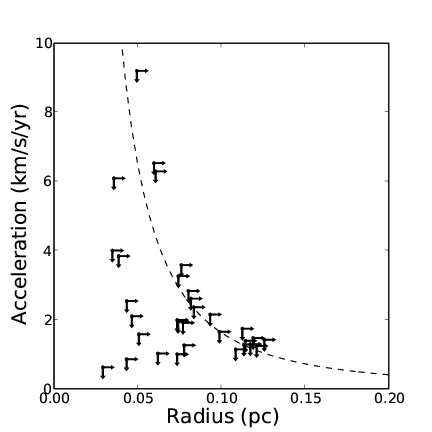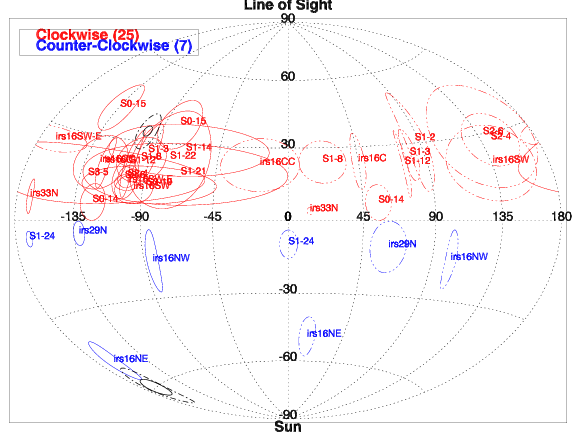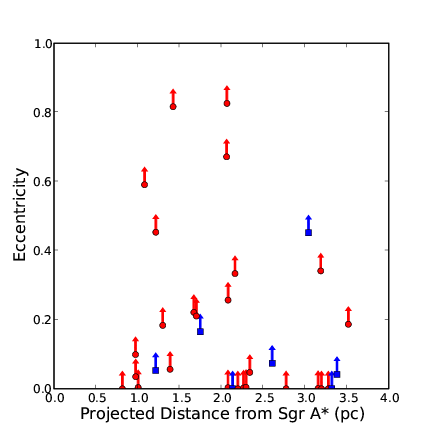
 GCNEWS
GCNEWS
A Newsletter for Galactic Center Research
Currently edited by Sera Markoff, Loránt Sjouwerman, Joseph Lazio, Cornelia Lang, Rainer Schödel, Masaaki Sakano & Feng Yuan
email: gcnews@aoc.nrao.edu

 GCNEWS
GCNEWS


Jessica R. Lu(1), A. M. Ghez(1), S. D. Hornstein(1), M. Morris(1),
K. Matthews(2), D.J. Thompson(3), and E. E. Becklin(1)
(1) UCLA Division of Astronomy
(2) Caltech Optical Observatory
(3) LBT Observatory, U Arizona
One peculiar attribute of our Galactic center is the presence of a population of massive (30 - 120 Mo), young (< 10 Myr) stars within the sphere of influence of the supermassive black hole (see e.g. [1,2]). The origin of such young stars is puzzling given that the present-day gas density is orders of magnitude too low to overcome the extreme tidal forces and collapse to form stars ([3,4]). Proposed resolutions to this ``paradox of youth'' include scenarios in which these young stars formed in a massive, self-gravitating accretion disk that was once present around the black hole ([5]) or alternatively, formed far from their current positions, outside the black hole's sphere of influence, as part of a massive star cluster which spiraled in via dynamical friction and deposited the most massive stars where we see them today ([6]). Both of the above possible formation scenarios predict that the stars should lie in a common orbital plane, which is supported by analyses using the stars' observed 3D velocities that show indirect evidence for two perpendicular, counter-rotating disks with inner disk radii of around 1 arcsec ([5,7]). However, formation in a self-gravitating accretion disk tends to suggest circular orbits while in-falling cluster scenarios could give rise either to circular or eccentric orbits.
In this article, we present results on the stellar orbits for the young stars that lie in the candidate disks ([8]). These orbits are used to test for the existence of two stellar disks and measure the eccentricities of the stars in order to distinguish between the various formation scenarios.
This study uses 11 years of diffraction-limited, infrared images of the Galaxy's central stellar cluster taken using both speckle and laser guide star adaptive optics (LGSAO) observing techniques at the 10 m Keck telescopes. For a sample of 33 young stars between 0.''8 and 3.''2 from the SBH, astrometry is extracted from the Keck data and radial velocities are obtained from the literature ([2]). Velocities in the plane of the sky are derived from the astrometric measurements by fitting first-order polynomials to positions as a function of time, weighted by the positional uncertainties. The measured proper motion are as much as ten times more precise than our most recent work in ([9]) with typical absolute uncertainties of 1-2 km/s. This substantial improvement comes from removing a small amount of residual geometric distortion from the NIRC-speckle data sets. Although this distortion is negligible near the center of the images, where Sgr A* and the central arcsecond sources are located; the astrometric accuracy of stars at larger radii is dominated by this residual distortion term. Given the improved precision, accelerations in the plane of the sky are derived by fitting second-order polynomials and many of the stars show a significant lack of acceleration given their projected distances from the SBH. Figure 1 shows the resulting acceleration limits for all the young stars in the sample as compared to the theoretical curve of acceleration as a function of radius.

For the sample of 33 young stars, we compute orbits for each star, assuming a Keplerian orbit model in which the gravitational potential arises from a single dominant point mass situated at the photometric centroid of Sgr A*. The mass and the distance to Sgr A* are fixed at values set by S0-2's orbit with M_o=3.69*106 Mo and R_o=7.36 kpc ([10]). For each star, there are then six free parameters: period (P), eccentricity (e), time of periapse passage (T_o), inclination (i), position angle of the ascending node (Omega), and the longitude of periapse. Not all of these parameters can be well constrained given that the stars have significant measurements of the 2D positions, 3D velocities, while there are only upper limits to the acceleration in the plane of the sky for the majority of the stars. Orbit fitting is carried out by minimizing the X2 value between the data and the model using the Thiele-Innes method ([11]). Uncertainties in the fits are characterized by fully exploring orbital parameter space and empirically determining those orbital solutions with X2 < X2min + 1 for 1 sigma errors.
Constrained orbital parameters include the angle to the ascending node (Omega) and the inclination (i), which can be combined to determine the orientation of each star's orbital plane. Figure 2 shows the orientation for all the stars' orbital planes. Some stars have two possible orbital solutions since the star's unknown line of sight distance from the SBH can either be positive or negative (behind or in front of the plane of the SBH). One of the solutions for the clockwise (red) stars' normal vectors cluster around a common point indicating that these stars may lie on a common orbital plane. The counter-clockwise stars, plotted in blue, do not appear to cluster around any single point, suggesting that they do not lie on a common orbital plane. Over plotted in black are the candidate orbital planes proposed by ([5]) and ([7]) with updated values from ([2]) for the candidate plane normal vectors (solid black) and disk thickness (dashed black). Although the proposed counter-clockwise disk is not supported by the sample of young stars in this work (all within 3'' of Sgr A*), our current observations cannot definitively rule out the existence of a 2nd disk until we expand our study to include more young stars at larger radii.

Determining the existence of a second disk is critical to understanding the formation scenarios of the young stars within the central parsec. For the self-gravitating accretion disk scenario, it is unlikely that two gas disks could exist simultaneously at the same radii since the disks would collide. Since the clockwise and counter-clockwise populations appear to have similar ages of 6 million years old to within 1 million years of each other ([2]), the existence of two stellar disks at the present epoch would mean that a second gas disk must have formed, become massive enough to collapse under self-gravity, and fragmented to form stars within, at most, 1 million years of the first gas disk. Likewise, for the in-falling cluster scenario, two nearly perpendicular disks of stars most likely cannot be formed by the infall of a single star cluster. The existence of two stellar disks would arise from two clusters spiraling in within 6 million years of each other, as set by the clusters' ages, and would thus give an estimate of the frequency of such cluster infall events.
On the other hand, if there is only one disk plus a randomly scattered population, then it may be possible to explain all the stars within the central parsec with a single formation scenario with scattering events giving rise to out-of-the-plane members. This scenario has a difficulty in that IRS 13 appears to be a large cluster of young stars; which either does not lie on the common orbital plane or is counter-rotating within this plane. There is no obvious mechanism for drastically changing the orbit of the highest density portion of the young star disk.

Stars in both disks show evidence for eccentric orbits. Of the 26 stars that may be in the clockwise disk, 10 of the stars have 3 sigma lower limits to their eccentricities of >0.2. Figure 3 shows the 3 sigma limit on eccentricities for all the stars in the sample. These eccentricity limits are robust as there is a sharp lower limit in chi-squared vs. eccentricity space. Eccentricities of > 0.4 may be difficult to explain with a self-gravitating accretion disk formation scenario. Results from Nayakshin & Cuadra ([12]) indicate that stars born in a circular accretion disk would retain their nearly circular orbits well past the present epoch. If the disk mass is built up from many small cloud-infall events, then the disk may circularize prior to becoming massive enough to form stars from self-gravity (>104 Mo); however, for a single massive cloud infall or a cloud-cloud collision event, it remains to be determined if star formation can occur rapidly enough that the cloud's initial eccentricity is imparted to the subsequently formed stars before circularizing.
High eccentricity orbits may be more naturally explained in the in-falling star cluster formation scenario. Stars that are stripped from a cluster as it spirals in should have a similar inclination, semi-major axis, and eccentricity as the cluster itself. Therefore, an in-falling cluster with an initially eccentric orbit will produce a thin disk of stars with similarly eccentric orbits ([13]). However, this formation scenario has its own share of unresolved issues including (1) the required high initial cluster mass (> 105 - 106 Mo, ([14,15]); (2) the required high central density, possibly even the presence of an intermediate mass black hole ([16,14]); and (3) the lack of observational evidence for tidally stripped stars at larger radii or X-ray emission from pre-main sequence low-mass stars within the central parsec ([17]).
In summary, we have retroactively improved our 11 year astrometric data set used for monitoring stellar orbits in the Galactic center. This has resulted in improved proper motions with uncertainties of only 1-2 km/s. We have attempted the first orbit fitting of the young stars proposed to lie in stellar disks orbiting the supermassive black hole. The individual orbits for the young stars confirm a disk of young stars at a high inclination rotating in a clockwise sense. The counter-clockwise rotating stars do not appear to be consistent with the previously proposed second disk. Stars within the well-defined, clockwise disk also appear to have high eccentricities, which is challenging to current accretion disk formation scenarios and provides a new observational constraint for models of star formation in the Galactic center.
[1] D. A. Allen, A. R. Hyland, and D. J. Hillier.
MNRAS, 244:706-713, June 1990.
[2] T. Paumard, R. Genzel, F. Martins, S. Nayakshin, A. M. Beloborodov,
Y. Levin, S. Trippe, F. Eisenhauer, T. Ott, S. Gillessen,
R. Abuter, J. Cuadra, T. Alexander, and A. Sternberg.
ApJ, 643:1011-1035, June 2006.
[3] R. H. Sanders.
Nature, 359:131-+, September 1992.
[4] M. Morris.
ApJ, 408:496-506, May 1993.
[5] Y. Levin and A. M. Beloborodov.
ApJLett, 590:L33-L36, June 2003.
[6] O. Gerhard.
ApJLett, 546:L39-L42, January 2001.
[7] R. Genzel, R. Schöodel, T. Ott, F. Eisenhauer, R. Hofmann,
M. Lehnert, A. Eckart, T. Alexander, A. Sternberg, R. Lenzen,
Y. Clénet, F. Lacombe, D. Rouan, A. Renzini, and L. E.
Tacconi-Garman.
ApJ, 594:812-832, September 2003.
[8] J. R. Lu, A. M. Ghez, S. D. Hornstein, M. Morris, K. Matthews, D. J.
Thompson, and E. E. Becklin.
In R. Schöodel, G. C. Bower, M. P. Muno, S. Nayakshin,
and T. Ott, editors, Conf. Proceed.: From the Center of the Milky Way
to Nearby Low-Luminosity Galactic Nuclei", 2006.
[9] J. R. Lu, A. M. Ghez, S. D. Hornstein, M. Morris, and E. E. Becklin.
ApJLett, 625:L51-L54, May 2005.
[10] Ghez et al.
in prep.
[11] W. H. van den Bos.
Univeresity of Chicago Press, 1962.
[12] S. Nayakshin and J. Cuadra.
A&A, 437:437-445, July 2005.
[13] S. J. Berukoff and B. M. S. Hansen.
ApJ, 650:901-915, October 2006.
[14] S. S. Kim, D. F. Figer, and M. Morris.
ApJLett, 607:L123-L126, June 2004.
[15] M. A. Gürkan and F. A. Rasio.
ApJ, 628:236-245, July 2005.
[16] B. M. S. Hansen and M. Milosavljevic;.
ApJLett, 593:L77-L80, August 2003.
[17] S. Nayakshin and R. Sunyaev.
MNRAS, 364:L23-L27, November 2005.